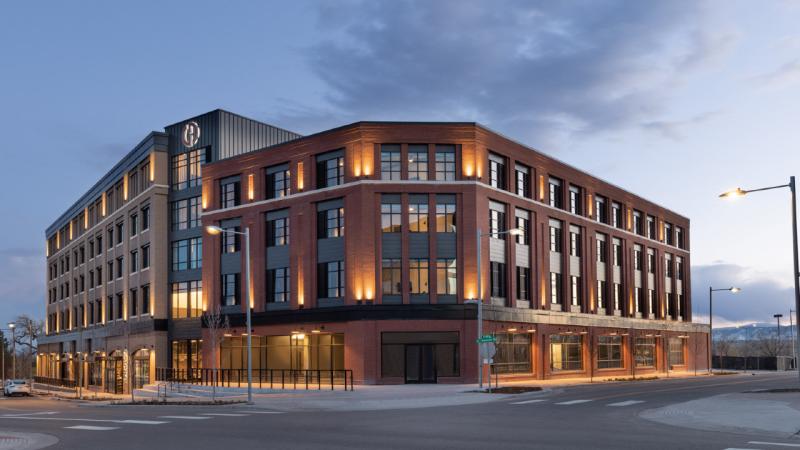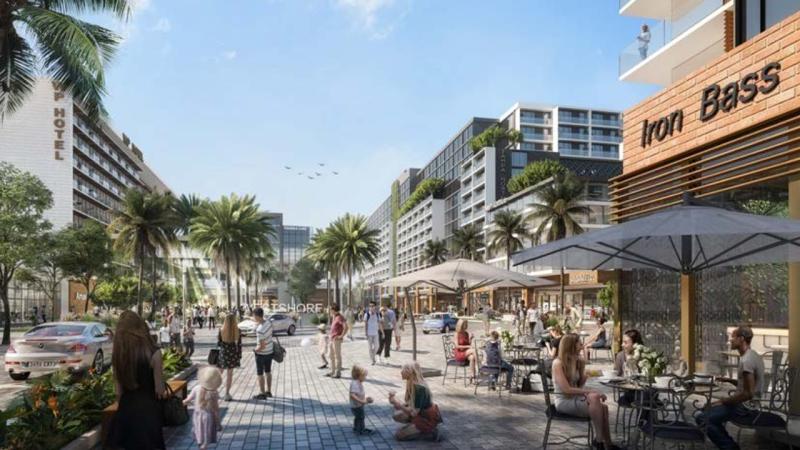Retail malls across the United States and Canada are being repositioned to mixed-use or redeveloped completely to new uses, such as office buildings, housing, education, healthcare/medical facilities, warehouses, and even town centers for suburban communities.
While this trend began more than a decade ago, the Covid-19 pandemic accelerated the shift in enclosed malls to mixed-use projects, as well as a consumer preference for open-air lifestyle retail centers, which has played a role in the downturn in mall performance.
The most successful malls are retaining their retail components and adding other uses and entertainments to make them a more attractive, compelling, experiential place and attract more foot traffic. An analysis by real estate advisory and brokerage firm JLL of 153 U.S. mall redevelopments underway found that 46 percent are mixed-use projects that are incorporating at least three uses. The most popular additions are housing (53.5 per cent), office (34.6 per cent), hotels (22.2 per cent), and health and medical facilities (13.1 per cent).
In a sample of 23 mall redevelopments in Canada’s largest markets (Montreal and Vancouver), nearly 100 percent are mixed-use projects that add housing (98.7 per cent}, office (42 per cent), and hotels (9 per cent). Additionally, 82 percent of projects are enhancing retail offerings, and about 45 percent are creating mass transit connections.
Region specific
While conversion of malls to a mix of uses is happening broadly across North America, these projects are the easiest to justify financially in metro areas with large dense or growing populations, says James Cook, director of North American Retail Research at JLL, noting that California is seeing the most mall mixed-use redevelopments, followed by Texas and Florida.
Tim Dick, executive vice president of CBRE Hotels Advisory, notes, however, that these projects can make sense wherever there is population growth, like the U.S. Southeast and West.
Trends, market dynamics, and economics are driving this transition. Cook notes, for example, that American consumers’ shopping and lifestyle preferences have changed radically over the last decade to a live, work, play environment, especially for younger consumers who want to live and work in a lively environment. He also says that the dire shortage of housing has made residential a popular addition to these projects.
Housing in malls is a win-win for retailers and residents alike, providing retailers and restaurants a clientele base in the neighborhood and residents with retail amenities at their doorstep.

Dick also notes that malls provide a busy dynamic similar to the energy of a town center, which makes hotels in malls attractive to visitors, because dining options and something to do. “People like to people-watch and want to be in places where things are happening,” he says. “Retail provides this, and at the same time, visitors can either shop or window shop,” Dick adds, noting that malls are also considered to be safe, which is another appealing aspect.
Dick says that critical considerations for mall redevelopments are: the site’s location—is it highly visible and accessible, the vibrancy and health of the mall, the economic climate and condition of the submarket and local retail market that serves the retail shopping area, and the market demographics within a three- to five-mile ring around the mall—where the shoppers come from. Additionally, what is the area’s per capita or per household income and spending habits of local consumers?
Market demand
JLL’s global head of Hotels Research, Zach Demuth stresses that the viability of hotels in a mall environment is a function of market demand, location, and what’s in the mall itself. For a hotel to be successful in this location, he explains that there must be proximity to something that draws or attracts guests, such as tourist attractions, a nearby conference center, or office parks.
Dick suggests, however, that these hotels can provide lodging for a variety of visitors, such friends and family in town for a bar mitzvah, wedding, retirement, graduation, bachelor or bachelorette party, or other events; conducting business in nearby offices; or attending a conference, festival, concert, or other area event, as well as for leisure travelers.
“Every shopping center and mall is different, and successful hospitality projects are heavily dependent on the local market,” agrees Mark K. Owens, vice chair of Capital Markets and Hospitality Practice Group Leader at Colliers, real estate advisory and brokerage firm. He notes that a hotel at Honolulu’s Ala Moana Center, one of the country’s leading luxury malls, will be very different than a lodging product at a regional mall.
Local dynamics
When adding a hotel to a mall, it is of paramount importance for the investors/developers to understand local dynamics, Owens adds, noting considerations relevant to the type of hotel product incorporate, such the type of guests and likely duration of their stay. Is the location is attractive to affluent and international travelers and how long will they stay? Are there other demand generators in the area? Is the mall a local or regional destination? What are the location’s demographics, and who are its consumers?
Ala Moana Center, for example, has a Manta hotel and Accor brand, and a new Renaissance is opening there soon, while extended-stay and limited- or select-service brands are more suitable for malls with a local or regional clientele, Owens says.
Demuth says that there are basically two types of hotels going into the majority of malls, brands, like Marriott’s Autograph Collection that create a sense of place, or select-service brands like Hampton Inn by Hilton that are designed more for consistency and function.
Some examples include The Houston Galleria, which has two Westin hotels and the Hotel Vesper from Marriott’s upscale, soft Tribute Portfolio, and The King of Prussia mall outside of Philadelphia, which has a variety of lodging options across brand families, including Hyatt, IHG, Marriott and Hilton that span consumer price points.
Planned redevelopments
While mall locations that make good sense for hoteliers are more limited than for housing or office uses, there are a number of hotels underway or planned in mall redevelopments nationwide.
A 400-room hotel is planned at Centennial’s MainPlace Mall in Santa Ana, Calif., which is located in the middle of an office center. The project also is curating and expanding retaik abd adding housing and office product.
The 2.5-million-square-foot redevelopment of Washington, D.C.-based EDENS North Dekalb Mall, rebranded Lulah Hills, in an Atlanta suburb, includes a 150-room hotel 1,700 apartments units, 100 for-sale condominiums, and a Path Foundation trail connection to nearby Emory University.

The redevelopment of Westminster Mall to a mixed-use town center for Westminster, Colorado, a suburb of Denver, includes a 125-room, Origin Westminster, a five-story, $22-million, 94,000 sq. ft. boutique hotel by Wyndham. The hotel, which is LEED-certified (Leadership in Energy and Environmental Design), is features a conference and event space, state-of-the-art fitness center, and on-site restaurant, and bookstore. (photo courtesy of Origin Westminster hotel)
A 100- or 150-room upscale, boutique hotel is planned at Merlone Geier Partners’ mixed-use makeover of the Laguna Hills Mall in Laguna Hills, Calif., which is situated along the I-5 freeway and nearby Laguna Beach—a tourist destination. The mall, which has been rebranded Village at Laguna Hills, also includes 250,000 sq. ft. of retail, 1,500 residential units, and nearly 500,000 sq. ft of office space.
Two malls undergoing redevelopment in Tampa, Fla., also will have hotels. MG2 Group’s Westshore Plaza mall, which is situated in a prime location along I-275 near the bridge to St. Petersburg, is undergoing redevelopment with a mix of uses, including housing, office, hospitality, retail, and restaurants. University Mall, which is nearby the University of South Florida, has been rebranded to RITHM@Uptown and is being redeveloped by RD Management as an urban mixed-use neighborhood and innovation center that includes housing, office, hospitality, entertainment, retail and medical uses and life science and technology research facilities.
Redevelopment plans by Red Development for Paradise Valley mall near Phoenix , now simply known as PV, includes the addition of hospitality, residential, entertainment, upscale restaurants, a central park and gathering places for events.
Meanwhile, a total of $750 million will be invested in redeveloping Metrocenter mall in Phoenix to a mixed-use neighborhood called The Village by a partnership of CWC (Concord Wilshire Capital), TLG Investment Partners, and Houston-based Hines. This 68-acre project will include two hotels, as well as 2,600 multifamily units, 100,000 sq. ft. of essential and service retail, a 150,000 Walmart Supercenter, a library and other public services, and open space geared to recreational uses.
Tremendous upside
Demuth notes that a mix of uses makes projects more feasible in today’s high-interest environment, as it lowers the risk for lenders, which increases the availability of construction loans and improves loan terms.
Owens also notes that retail malls often have significant acreage in densely populated areas with good access to infrastructure, making them ideal locations for lodging. “As the retail market continues to evolve, lodging is a great opportunity to unlock land value or additional lease income by selling, leasing or creating a joint venture with lodging developers,” he adds, noting that hotels can activate dormant space, such as parking lots.
In addition, Owens points out that utilizing undeveloped land in shopping mall sites can help hotel projects to pencil by lowering the upfront cost of land. He also suggests that the array of amenities offered by a mall, including fitness centers, a variety of restaurants and bars, shopping, and entertainments, also may reduce or eliminate the need for a high-level of amenities in hotels.